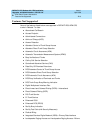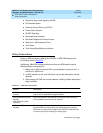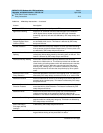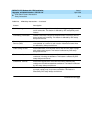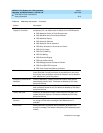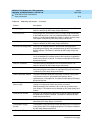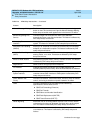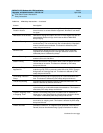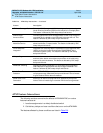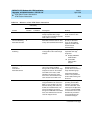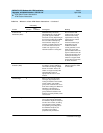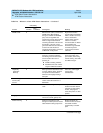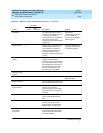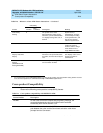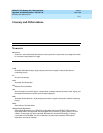
DEFINITY ECS Release 8.2 ATM Installation,
Upgrades, and Administration
555-233-124
Issue 1
April 2000
ATM Switch Feature Interactions
B-18Delay Interactions
B
Recorded Telephone
Dictation Access
Permits voice-terminal users, including Remote Access and incoming
tie-trunk users, to access dictation equipment. No effect if user waits
for signal.
Redirection on No Answer Redirects a ringing ACD split or skill call or Direct Agent Call after an
administered number of rings. It will have an effect if WAN-PNC
delays ringing.
Ringback Queuing Places outgoing calls in an ordered queue (first-in, first-out) when all
trunks are busy. The voice-terminal user is automatically called back
when a trunk becomes available. This feature is affected by SVC
setup delays and failures.
Send All Calls Allows users to temporarily direct all incoming calls to coverage
regardless of the assigned call-coverage redirection criteria. The
forwarded phone is affected by delays.
Service Observing Allows a specified user, such as a supervisor, to observe or monitor
another user’s calls. No effect.
Station Hunting Routes calls made to a busy station down a chain of stations until one
is found that is not active. This feature is affected by SVC setup
delays and failures.
Temporary Bridged
Appearance
Allows multi-appearance voice terminal users in a terminating
extension group (TEG) or personal central office line (PCOL) group to
bridge onto an existing group call. This feature is affected by SVC
setup delays and failures.
Terminating Extension
Group
Allows an incoming call to ring as many as 4 voice terminals at one
time. This feature is affected by SVC setup delays and failures.
Time of Day Routing Provides the most economical routing of ARS and AAR calls. This
feature is affected by different time zones.
Transfer Allows voice-terminal users to transfer trunk or internal calls to other
voice terminals or trunks without attendant assistance. This feature is
affected by SVC setup delays and failures.
Transfer Outgoing Trunk
to Outgoing Trunk
Permits a controlling party (such as a station user or attendant) to
initiate two or more outgoing trunk calls and then connect the trunks.
This feature is affected by SVC setup delays and failures.
Trunk-to-Trunk Transfer Allows the attendant or voice-terminal user to connect an incoming
trunk call to an outgoing trunk. This feature is affected by SVC setup
delays and failures.
Uniform Dial Plan Provides a common 4- or 5-digit dial plan (specified in the Dial Plan
Record) that can be shared among a group of switches. No effect.
Table B-5. ATM delay interactions — Continued
Feature Description
Continued on next page



